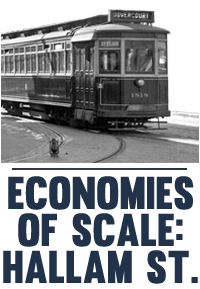Economies of Scale: Hallam St. is a project that began in 2008. It was initiated as a way to explore in more depth a question that arose for me every time I drove or cycled along Toronto’s Hallam St. A relatively short east-west street, running nine blocks from Dufferin St. to Shaw St., it was striking that at almost every intersection, with the notable exception of Dovercourt Rd., were small stores now mostly closed and being used for residential purposes. What happened to undermine what clearly was the once-thriving economy of this former neighbourhood high street? Of at least thirty stores along Hallam that had once been active, less than 10 were still functioning as such. As well, the street seemed just a little too wide for its current residential status. These observations pointed to a different past life for this street.
Research into its history was undertaken over several years and led me to the City of Toronto Archives (many times!), the local public library, to speak with a number of local residents and shop owners, to work with the local public school and to produce several artworks related to the area.
Focusing on the period from 1900 to 2000, this website attempts to consolidate my work as an artist/researcher. It identifies and brings together in one place a range of disparate issues, rooted mostly in the postwar period of the 20th century, that led to the gradual fading of Hallam Street’s once bustling economy. It must also be noted, though, that the urban cycle continues as the street and community are showing signs of a new but different life in the early 21st century as young families and new kinds of businesses move into the midtown Toronto neighbourhood.
Still a work-in-progress, the content and production of this website was made possible with the help of web designer Ian Bradshaw, research assistant Jackson Klie and supported through the generosity of the Dovercourt Village BIA, the Ontario Arts Council and Ryerson University.
Vid Ingelevics
November 2013

